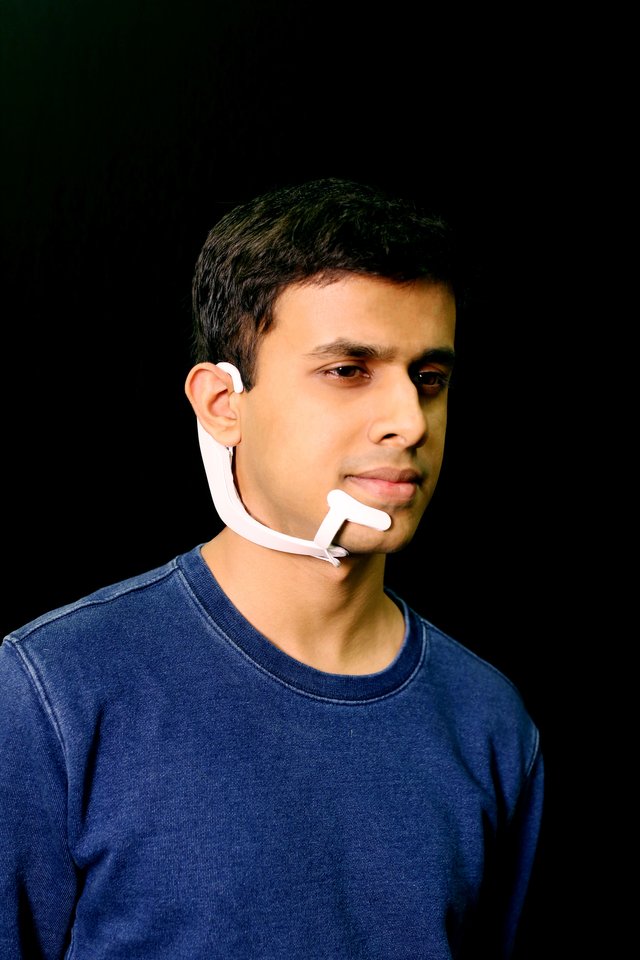

Students from MIT have created a prototype gadget, dubbed AlterEgo, that may acknowledge the phrases you mouth when silently speaking to your self—after which take motion based mostly on what it thinks you’re saying.
Arnav Kapur, a grasp’s pupil on the MIT Media Lab—a division of the Massachusetts Institute of Technology that focuses on the intersection of people and technology— and writer of the paper, stresses that the gadget doesn’t learn ideas or the random, stray phrases that simply occur to cross by way of your thoughts. “You’re completely silent, but talking to yourself,” he says. “It’s neither thinking nor speaking. It’s a sweet spot in between, which is voluntary but also private. We capture that.”
The prototype system, because it exists proper now, seems like a white headset a telemarketer may put on. But as an alternative of a mic hovering in entrance of their lips, it sticks to the face and neck, the place a handful of electrodes decide up the miniscule electrical indicators generated by the delicate inside muscle motions that happen whenever you silently discuss to your self. The gadget connects through Bluetooth to a pc, which then communicates with a server that interprets the indicators to find out what phrases the wearer is articulating.
It’s very a lot within the prototype stage, although it represents an enchanting departure from the norm. We most frequently work together with our units by touching them—typing on a smartphone, urgent on an app, or double tapping the aspect of Apple’s AirPods to pause or play music. Or, we discuss to our devices or good audio system by participating with digital helpers like Siri, Alexa, or the Google Assistant. Those companies require extra from you than talking silently to your self. Put one other manner: this kind of tech is like having a less complicated model of Siri hear your silent whispers.
The aim of all this? To additional “combine humans and computers,” Kapur says. The extra tightly we work together with computer systems, the extra we will benefit from their strengths—like shortly getting assist with a math downside or a translation—with out having to lookup out of your work and click on, faucet, or sort.
Or a person may merely change the channel on the Roku—these remotes are so small and simply misplaced!—in whole silence. The AlterEgo additionally appears promising for folks with disabilities, or paralysis. But Kapur says they haven’t been capable of examine that software but.
To make certain, the tech continues to be in its early levels, so every app solely has the capability to study 20 totally different phrases. The system can’t perceive each phrase an individual says—simply those it has been taught. Talking to your self intentionally, however not saying something out loud, is a simple observe to study, Kapur says. When coaching somebody to make use of it, they begin by asking them to learn a passage aloud. “After that, we ask them to not voice the words” as they learn, he says. “It’s more comfortable than speaking out loud.”
To construct the system, Kapur used a standard synthetic intelligence device known as a neural network, which may study from knowledge inputs. They skilled the neural community to acknowledge how totally different electrical indicators correspond to the totally different phrases an individual may say to themselves.
While it’s straightforward to see army purposes of such a tool—a professor from Georgia Tech’s College of Computing, Thad Starner, mentioned in a statement on MIT’s website that he may envision “special ops” utilizing such a tool—Kapur says that’s not their meant aim for the system.
“This is more about how we could bridge the gap between computers and humans,” he says. The splendid state of affairs is one during which folks can increase themselves with the smarts of a synthetic intelligence system easily and in actual time.
The subsequent step: work on the gadget’s type, so it’s a bit “more invisible.” It’s all about that seamless integration—so ideally future variations received’t appear like a taped-on telemarketer’s headset.
Source